Chris Greening
@greening.bsky.social
Professor & NHMRC Fellow at Monash University, Melbourne. Using microbes to tackle global challenges in health and sustainability. #FirstGen 🐶🇦🇺🌈🎹🌱
Reposted by Chris Greening
In our latest collection of free education resources, we explore bioconversion with Professor Esteban Marcellin, Professor @greening.bsky.social and Dr Leonie Van 't Hag from the RECARB hub. They are using bioconversion to convert greenhouse gases into proteins.
futurumcareers.com/tackling-cli...
futurumcareers.com/tackling-cli...



October 22, 2025 at 9:54 AM
In our latest collection of free education resources, we explore bioconversion with Professor Esteban Marcellin, Professor @greening.bsky.social and Dr Leonie Van 't Hag from the RECARB hub. They are using bioconversion to convert greenhouse gases into proteins.
futurumcareers.com/tackling-cli...
futurumcareers.com/tackling-cli...
Why can our farts ignite? Time to find out (and quite a bit more) in our new paper in Nature Microbiology led by the amazing Dr Cait Welsh. Integrating atomic-to-ecosystem level insights. www.nature.com/articles/s41...

A widespread hydrogenase supports fermentative growth of gut bacteria in healthy people - Nature Microbiology
A previously uncharacterized microbial enzyme is responsible for the production of molecular hydrogen in the gut, which drives the growth of other bacteria and has implications for human health.
www.nature.com
October 24, 2025 at 10:24 AM
Why can our farts ignite? Time to find out (and quite a bit more) in our new paper in Nature Microbiology led by the amazing Dr Cait Welsh. Integrating atomic-to-ecosystem level insights. www.nature.com/articles/s41...
Reposted by Chris Greening
Cool study on aerotolerant methanogens! Options they might protect themselves from O2 include biofilm formation in response to O2 exposure and antioxidants (F420-H2-oxidases, rubredoxins, thioredoxins, and peroxiredoxins). This opens up a vareity of new possible habitats for methanogens.
Check this nice first first-author paper by Ning Hall—now out in Nature Geoscience! Our team had a blast supporting Ning on the isolation workflow, and a few of the standout Methanococcoides strains even trace back to our Danish waters. 🌊
www.nature.com/articles/s41...
www.nature.com/articles/s41...

Coastal methane emissions driven by aerotolerant methanogens using seaweed and seagrass metabolites - Nature Geoscience
Experiments suggest aerotolerant archaea produce methane in the surface layers of coastal sandy sediments and that this activity is driven by seaweed and seagrass metabolites.
www.nature.com
August 8, 2025 at 3:27 PM
Cool study on aerotolerant methanogens! Options they might protect themselves from O2 include biofilm formation in response to O2 exposure and antioxidants (F420-H2-oxidases, rubredoxins, thioredoxins, and peroxiredoxins). This opens up a vareity of new possible habitats for methanogens.
Reposted by Chris Greening
New preprint up now!
Interested in the evolution of halophily within DPANN archaea we decided to investigate the sister phylum to the Nanohaloarchaeota, GTDB phylum EX4484-52, for which we propose the name Caliditerrarchaeota
www.biorxiv.org/content/10.1...
Interested in the evolution of halophily within DPANN archaea we decided to investigate the sister phylum to the Nanohaloarchaeota, GTDB phylum EX4484-52, for which we propose the name Caliditerrarchaeota
www.biorxiv.org/content/10.1...

Caliditerrarchaeota, a new sister to Nanohaloarchaeota, provides insights into the evolution of DPANN halophily
The Nanohaloarchaeota are a clade of halophilic symbionts with small cells and genomes. Originally placed within the Euryarchaeota, they are now widely thought to belong to the DPANN archaea. However,...
www.biorxiv.org
August 8, 2025 at 6:49 AM
New preprint up now!
Interested in the evolution of halophily within DPANN archaea we decided to investigate the sister phylum to the Nanohaloarchaeota, GTDB phylum EX4484-52, for which we propose the name Caliditerrarchaeota
www.biorxiv.org/content/10.1...
Interested in the evolution of halophily within DPANN archaea we decided to investigate the sister phylum to the Nanohaloarchaeota, GTDB phylum EX4484-52, for which we propose the name Caliditerrarchaeota
www.biorxiv.org/content/10.1...
Masterpiece paper from Ning, Perran, Amelia and co! Great mix of field-based geochemistry, laboratory manipulations, methanogen cultivation, and isolate / environmental genomics. An unexpected feedback between eutrophication and climate change that could shake up how we think about methane budgets.
Check this nice first first-author paper by Ning Hall—now out in Nature Geoscience! Our team had a blast supporting Ning on the isolation workflow, and a few of the standout Methanococcoides strains even trace back to our Danish waters. 🌊
www.nature.com/articles/s41...
www.nature.com/articles/s41...

Coastal methane emissions driven by aerotolerant methanogens using seaweed and seagrass metabolites - Nature Geoscience
Experiments suggest aerotolerant archaea produce methane in the surface layers of coastal sandy sediments and that this activity is driven by seaweed and seagrass metabolites.
www.nature.com
August 8, 2025 at 3:51 AM
Masterpiece paper from Ning, Perran, Amelia and co! Great mix of field-based geochemistry, laboratory manipulations, methanogen cultivation, and isolate / environmental genomics. An unexpected feedback between eutrophication and climate change that could shake up how we think about methane budgets.
1/3 Electricity from air! In the top journal Nano Energy today, we report the first fuel cell that makes power from air alone. We achieved this by using the enzyme Huc to oxidize ambient hydrogen. This results in a continuous low-level power from air and higher outputs with industrial waste gases.

Nanoengineered bioanode with oxygen-insensitive hydrogenase for sustainable energy harvesting from atmospheric hydrogen and waste gases
Enzymatic biofuel cells (EBFCs) utilizing hydrogenases to oxidize hydrogen offer a sustainable approach to energy conservation. However, the oxygen se…
www.sciencedirect.com
August 8, 2025 at 3:49 AM
1/3 Electricity from air! In the top journal Nano Energy today, we report the first fuel cell that makes power from air alone. We achieved this by using the enzyme Huc to oxidize ambient hydrogen. This results in a continuous low-level power from air and higher outputs with industrial waste gases.
Reposted by Chris Greening
Does the atmosphere harbour a resident, growing microbial ecosystem? ⛅
Here in @jgrbiogeo.bsky.social we outline how theoretical tools 📝 & modelling 💻 can bring us closer to the answer
Congrats lead author @drmartinezrabert.bsky.social @mioceanologie.bsky.social
🧵 thread 👇
tinyurl.com/7pdfm7uw
Here in @jgrbiogeo.bsky.social we outline how theoretical tools 📝 & modelling 💻 can bring us closer to the answer
Congrats lead author @drmartinezrabert.bsky.social @mioceanologie.bsky.social
🧵 thread 👇
tinyurl.com/7pdfm7uw
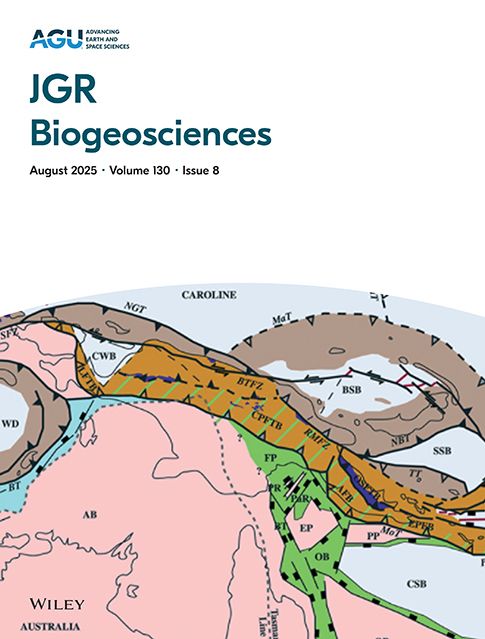
Investigating the Atmospheric Microbial Ecosystem Through Theory, Bioenergetics, and Numerical Modeling: A Breath of Fresh Air for Aeromicrobiology
Aerobiology research is hindered by several technical challenges facing experimental studies, sampling, and monitoring strategies Theoretical approaches and numerical modeling tools provide power...
tinyurl.com
July 31, 2025 at 9:42 AM
Does the atmosphere harbour a resident, growing microbial ecosystem? ⛅
Here in @jgrbiogeo.bsky.social we outline how theoretical tools 📝 & modelling 💻 can bring us closer to the answer
Congrats lead author @drmartinezrabert.bsky.social @mioceanologie.bsky.social
🧵 thread 👇
tinyurl.com/7pdfm7uw
Here in @jgrbiogeo.bsky.social we outline how theoretical tools 📝 & modelling 💻 can bring us closer to the answer
Congrats lead author @drmartinezrabert.bsky.social @mioceanologie.bsky.social
🧵 thread 👇
tinyurl.com/7pdfm7uw
Our article showing energy production from air alone is in PNAS today. This paper provides an ultimate biochemical proof that microbes can survive simply by 'making' energy from air (making two ATP per molecule atmospheric H2 consumed) and has biotech applications. www.pnas.org/doi/10.1073/...
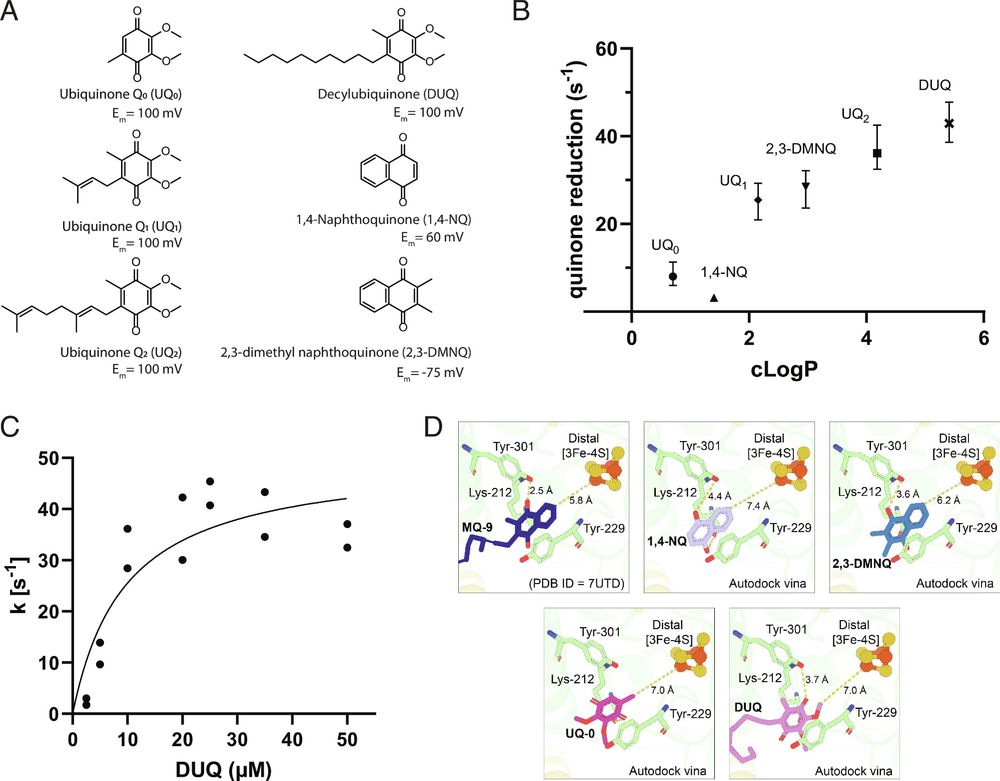
ATP synthesis driven by atmospheric hydrogen concentrations | PNAS
All cells require a continuous supply of the universal energy currency, adenosine
triphosphate (ATP), to drive countless cellular reactions. The un...
www.pnas.org
July 25, 2025 at 12:54 AM
Our article showing energy production from air alone is in PNAS today. This paper provides an ultimate biochemical proof that microbes can survive simply by 'making' energy from air (making two ATP per molecule atmospheric H2 consumed) and has biotech applications. www.pnas.org/doi/10.1073/...
Reposted by Chris Greening
Out in @natbiotech.nature.com: Metagenome taxonomy profilers usually ignore unknown species. SingleM is an accurate profiler which doesn't, even detecting phyla with no MAGs. Profiles of 700,000 metagenomes at sandpiper.qut.edu.au. A 🧵

July 16, 2025 at 9:59 PM
Out in @natbiotech.nature.com: Metagenome taxonomy profilers usually ignore unknown species. SingleM is an accurate profiler which doesn't, even detecting phyla with no MAGs. Profiles of 700,000 metagenomes at sandpiper.qut.edu.au. A 🧵
Reposted by Chris Greening
Extraordinary keynote lecture by Prof. Chris Greening @greening.bsky.social about Microbial oxidation of atmospheric trace gases: from enzymes to ecosystems.
#FEMS2025 @femsmicro.org
#FEMS2025 @femsmicro.org

July 16, 2025 at 10:08 AM
Extraordinary keynote lecture by Prof. Chris Greening @greening.bsky.social about Microbial oxidation of atmospheric trace gases: from enzymes to ecosystems.
#FEMS2025 @femsmicro.org
#FEMS2025 @femsmicro.org
Reposted by Chris Greening
Getting inspired @femsmicro.org ! Thanks @greening.bsky.social for the very interesting talk !

July 16, 2025 at 10:13 AM
Getting inspired @femsmicro.org ! Thanks @greening.bsky.social for the very interesting talk !
Reposted by Chris Greening
Day 3 at #fems2025 started with an exciting and inspiring keynote by Chris @greening.bsky.social on microbes living out of thin air
@femsmicro.org
@femsmicro.org

July 16, 2025 at 8:35 AM
Day 3 at #fems2025 started with an exciting and inspiring keynote by Chris @greening.bsky.social on microbes living out of thin air
@femsmicro.org
@femsmicro.org
Reposted by Chris Greening
That's only half the issue - check out these great Reviews, too!
📝 Oxygen-adapted hydrogenases - @greening.bsky.social et al
📝 RNA processing in innate immunity - Kristen Lynch et al
📝 connexins and pannexins beyond the cell surface - Henrique Girao et al
📝 Oxygen-adapted hydrogenases - @greening.bsky.social et al
📝 RNA processing in innate immunity - Kristen Lynch et al
📝 connexins and pannexins beyond the cell surface - Henrique Girao et al
July 3, 2025 at 4:32 PM
That's only half the issue - check out these great Reviews, too!
📝 Oxygen-adapted hydrogenases - @greening.bsky.social et al
📝 RNA processing in innate immunity - Kristen Lynch et al
📝 connexins and pannexins beyond the cell surface - Henrique Girao et al
📝 Oxygen-adapted hydrogenases - @greening.bsky.social et al
📝 RNA processing in innate immunity - Kristen Lynch et al
📝 connexins and pannexins beyond the cell surface - Henrique Girao et al
Our new consensus statement on reducing and reporting contamination in microbiome studies is the cover image of this month's Nature Microbiology: www.nature.com/articles/s41... In the cover photo, you can see our postdoc Sophie Holland in fully PPE sampling the atmosphere of terrestrial Antarctica.
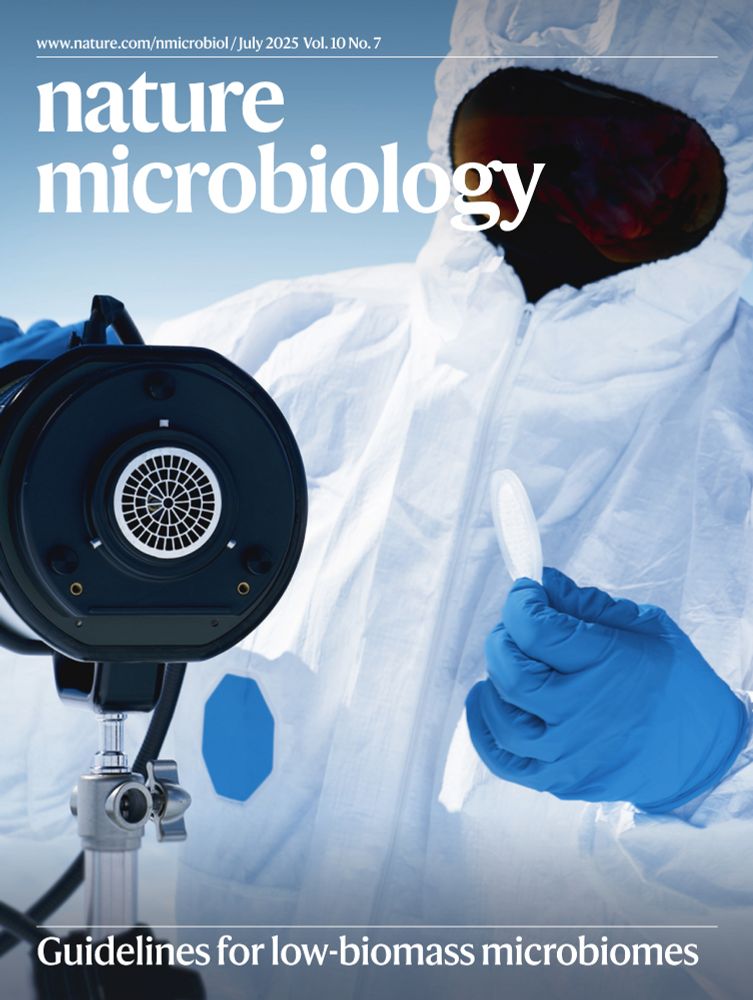
July 3, 2025 at 3:22 PM
Our new consensus statement on reducing and reporting contamination in microbiome studies is the cover image of this month's Nature Microbiology: www.nature.com/articles/s41... In the cover photo, you can see our postdoc Sophie Holland in fully PPE sampling the atmosphere of terrestrial Antarctica.
Reposted by Chris Greening
Guess who's the coverboi for @natmicrobiol.nature.com this month? 💁 A huge shout-out to Dr Rachael Lappan for entrusting me to carry out the sampling for this incredibly cool atmosphere microbiome project on her behalf, & to Braydon Moloney for capturing this moment in Antarctica last summer. [1/2]
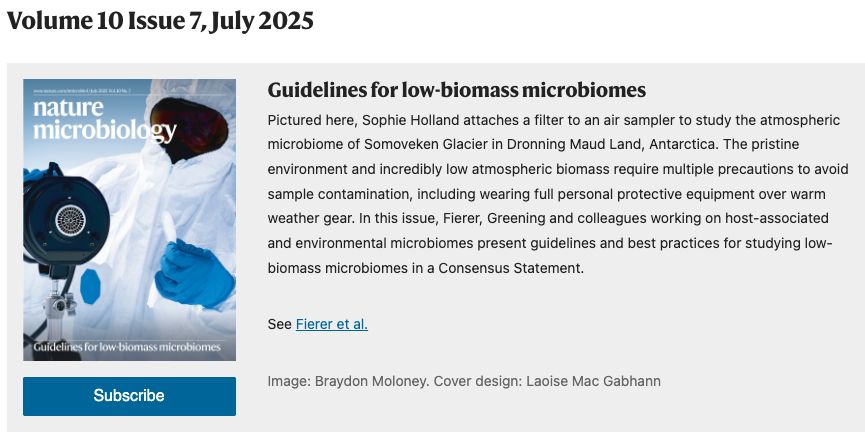
July 3, 2025 at 5:28 AM
Guess who's the coverboi for @natmicrobiol.nature.com this month? 💁 A huge shout-out to Dr Rachael Lappan for entrusting me to carry out the sampling for this incredibly cool atmosphere microbiome project on her behalf, & to Braydon Moloney for capturing this moment in Antarctica last summer. [1/2]
Reposted by Chris Greening
Our paper demonstrating that within-species warfare interactions are ecologically important on human skin is now published in Nature Micro! www.nature.com/articles/s41...
June 30, 2025 at 12:26 PM
Our paper demonstrating that within-species warfare interactions are ecologically important on human skin is now published in Nature Micro! www.nature.com/articles/s41...
Reposted by Chris Greening
Hope this is useful - consensus statement "Guidelines for preventing and reporting contamination in low-biomass microbiome studies" rdcu.be/er3Io
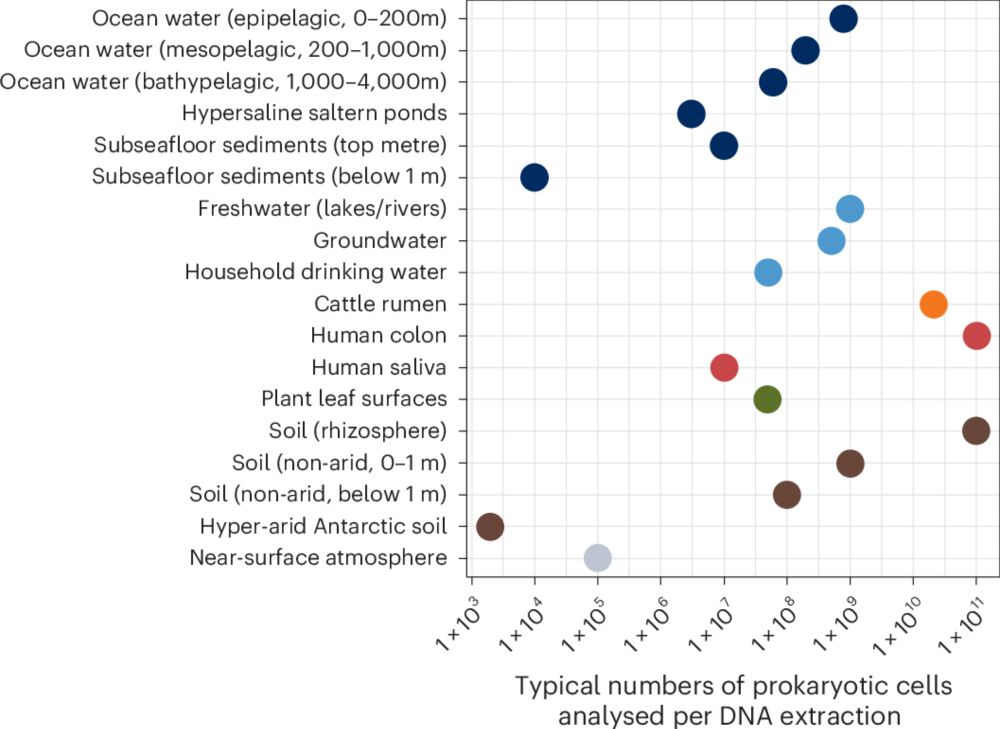
Guidelines for preventing and reporting contamination in low-biomass microbiome studies
Nature Microbiology - In this Consensus Statement, the authors outline strategies for processing, analysing and interpreting low-biomass microbiome samples, and provide recommendations to minimize...
rdcu.be
June 21, 2025 at 7:59 PM
Hope this is useful - consensus statement "Guidelines for preventing and reporting contamination in low-biomass microbiome studies" rdcu.be/er3Io
Reposted by Chris Greening
An editorial in @natmicrobiol.nature.com highlighted issues with reports dealing with low-biomass microbiome.
A new consensus statement provides guidelines to prevent and report contamination in low-biomass studies.
A step towards ensuring rigour!
#MIcrobiomeSky
www.nature.com/articles/s41...
A new consensus statement provides guidelines to prevent and report contamination in low-biomass studies.
A step towards ensuring rigour!
#MIcrobiomeSky
www.nature.com/articles/s41...
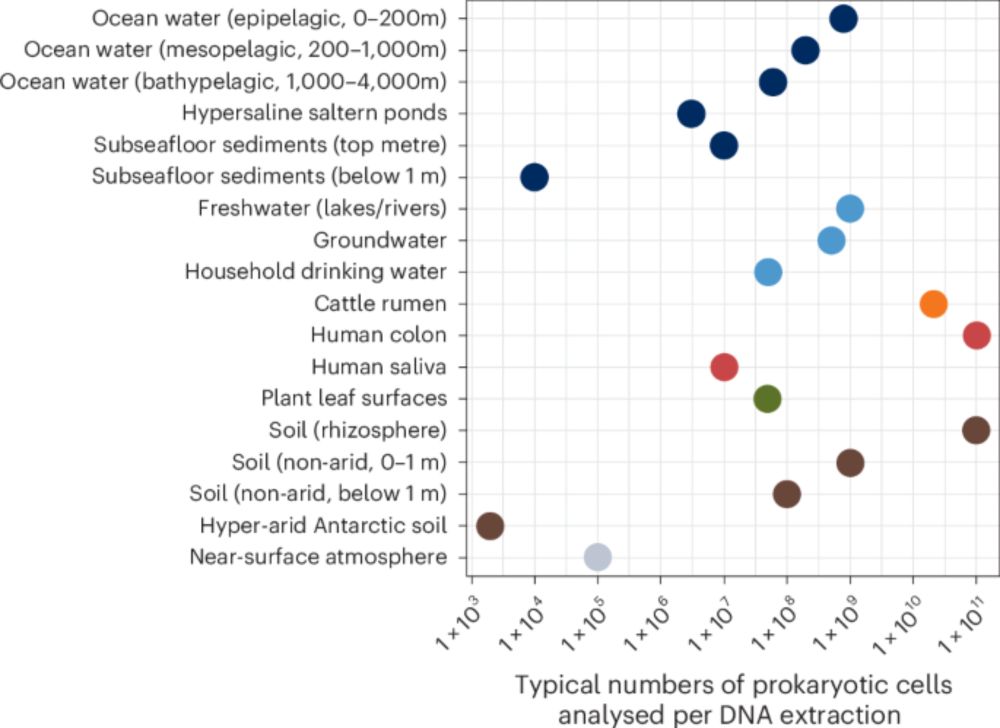
Guidelines for preventing and reporting contamination in low-biomass microbiome studies - Nature Microbiology
In this Consensus Statement, the authors outline strategies for processing, analysing and interpreting low-biomass microbiome samples, and provide recommendations to minimize contaminants.
www.nature.com
June 25, 2025 at 2:50 PM
An editorial in @natmicrobiol.nature.com highlighted issues with reports dealing with low-biomass microbiome.
A new consensus statement provides guidelines to prevent and report contamination in low-biomass studies.
A step towards ensuring rigour!
#MIcrobiomeSky
www.nature.com/articles/s41...
A new consensus statement provides guidelines to prevent and report contamination in low-biomass studies.
A step towards ensuring rigour!
#MIcrobiomeSky
www.nature.com/articles/s41...
Reposted by Chris Greening
A new Consensus Statement led by @greening.bsky.social and @noahfierer.bsky.social in @natmicrobiol.nature.com
Guidelines for preventing and reporting contamination in low-biomass microbiome studies
❗A must-read for anyone working in this field
#microsky 🧪🦠
www.nature.com/articles/s41...
Guidelines for preventing and reporting contamination in low-biomass microbiome studies
❗A must-read for anyone working in this field
#microsky 🧪🦠
www.nature.com/articles/s41...

Guidelines for preventing and reporting contamination in low-biomass microbiome studies - Nature Microbiology
In this Consensus Statement, the authors outline strategies for processing, analysing and interpreting low-biomass microbiome samples, and provide recommendations to minimize contaminants.
www.nature.com
June 23, 2025 at 10:37 AM
A new Consensus Statement led by @greening.bsky.social and @noahfierer.bsky.social in @natmicrobiol.nature.com
Guidelines for preventing and reporting contamination in low-biomass microbiome studies
❗A must-read for anyone working in this field
#microsky 🧪🦠
www.nature.com/articles/s41...
Guidelines for preventing and reporting contamination in low-biomass microbiome studies
❗A must-read for anyone working in this field
#microsky 🧪🦠
www.nature.com/articles/s41...
Reposted by Chris Greening
After some more awesome science from amongst others @greening.bsky.social, Simon Newstead & @martinsteinegger.bsky.social and unfortunately a long drive back home, we made it back to Umeå! Thank you #Sweprot and all participants for the great company and hopefully see you next year!




June 17, 2025 at 9:24 AM
After some more awesome science from amongst others @greening.bsky.social, Simon Newstead & @martinsteinegger.bsky.social and unfortunately a long drive back home, we made it back to Umeå! Thank you #Sweprot and all participants for the great company and hopefully see you next year!
Reposted by Chris Greening
Online now - the Review "Diverse lineages and adaptations of oxygen-adapted #hydrogenases" from @greening.bsky.social, @rhyswg.bsky.social, and colleagues.
#metalloenzyme #evolution #O2Tolerant #O2Sensitive #GasChannels
Read it here 👉 authors.elsevier.com/a/1lA2s3S6Gf...
#metalloenzyme #evolution #O2Tolerant #O2Sensitive #GasChannels
Read it here 👉 authors.elsevier.com/a/1lA2s3S6Gf...

May 29, 2025 at 2:19 PM
Online now - the Review "Diverse lineages and adaptations of oxygen-adapted #hydrogenases" from @greening.bsky.social, @rhyswg.bsky.social, and colleagues.
#metalloenzyme #evolution #O2Tolerant #O2Sensitive #GasChannels
Read it here 👉 authors.elsevier.com/a/1lA2s3S6Gf...
#metalloenzyme #evolution #O2Tolerant #O2Sensitive #GasChannels
Read it here 👉 authors.elsevier.com/a/1lA2s3S6Gf...
Reposted by Chris Greening
I'm absolutely taken by your work – and your team's work – on how microbes get by living from "thin air". it's only a "paradigm shift' for microbiologists brought up with the idea that bugs live by "feast or famine", what they do not only in the lab. but the famine part is way more interesting...
March 22, 2025 at 11:04 PM
I'm absolutely taken by your work – and your team's work – on how microbes get by living from "thin air". it's only a "paradigm shift' for microbiologists brought up with the idea that bugs live by "feast or famine", what they do not only in the lab. but the famine part is way more interesting...
Energy from air? No problem! In our new preprint, we reconstitute the machinery that allows microbes to endure starvation. By using the trace amounts of hydrogen in air alone, they produce plenty of chemical energy (2 ATP) to get by. The only byproduct? Water. www.biorxiv.org/content/10.1...

Hydrogenase-driven ATP synthesis from air
All cells require a continuous supply of the universal energy currency, adenosine triphosphate (ATP), to drive countless cellular reactions. The universally conserved F1Fo-ATP synthase regenerates ATP...
www.biorxiv.org
March 20, 2025 at 12:57 AM
Energy from air? No problem! In our new preprint, we reconstitute the machinery that allows microbes to endure starvation. By using the trace amounts of hydrogen in air alone, they produce plenty of chemical energy (2 ATP) to get by. The only byproduct? Water. www.biorxiv.org/content/10.1...
Reposted by Chris Greening
Hydrogenase-driven ATP synthesis from air
www.biorxiv.org/content/10.1...
New work from us where we put the Huc hydrogenase to work to see if it can generate a proton motive force. It can!
cc: @ashleighkropp.bsky.social @rhyswg.bsky.social @greening.bsky.social
www.biorxiv.org/content/10.1...
New work from us where we put the Huc hydrogenase to work to see if it can generate a proton motive force. It can!
cc: @ashleighkropp.bsky.social @rhyswg.bsky.social @greening.bsky.social
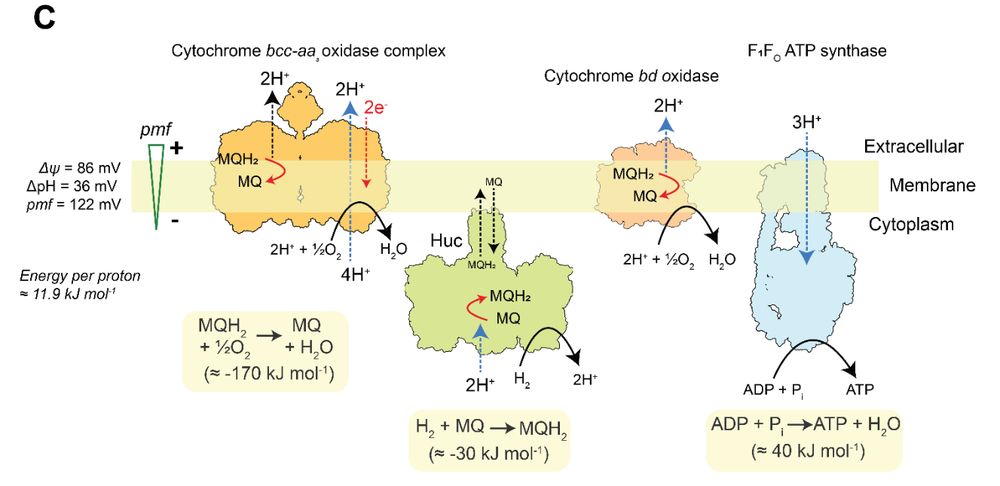
March 19, 2025 at 3:21 AM
Hydrogenase-driven ATP synthesis from air
www.biorxiv.org/content/10.1...
New work from us where we put the Huc hydrogenase to work to see if it can generate a proton motive force. It can!
cc: @ashleighkropp.bsky.social @rhyswg.bsky.social @greening.bsky.social
www.biorxiv.org/content/10.1...
New work from us where we put the Huc hydrogenase to work to see if it can generate a proton motive force. It can!
cc: @ashleighkropp.bsky.social @rhyswg.bsky.social @greening.bsky.social
Wonderful opportunity. So excited for where Sophie and our team have taken the Antarctic program.
Apply for a PhD in Antarctic microbial ecology 🦠🇦🇶❄️ with me, @greening.bsky.social and @arcsaef.bsky.social. We're interested in multi-kingdom interactions in terrestrial Antarctica, including mosses 🌱 with @antarcticmoss.bsky.social. Details www.findaphd.com/phds/project.... Please share widely!

PhD in Antarctic microbial ecology at Monash University on FindAPhD.com
PhD Project - PhD in Antarctic microbial ecology at Monash University, listed on FindAPhD.com
www.findaphd.com
February 27, 2025 at 11:01 PM
Wonderful opportunity. So excited for where Sophie and our team have taken the Antarctic program.

